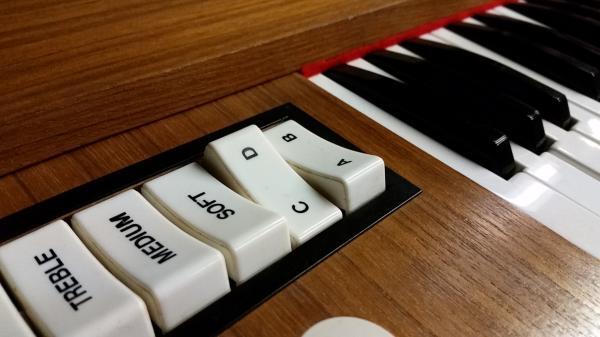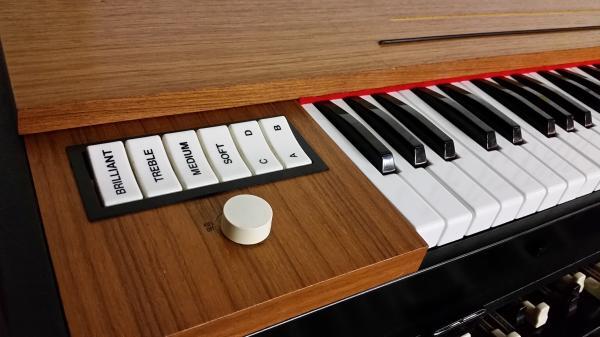The Clavinet Tone Control and Pickup Settings
How do the Clavinet Controls Work?
Players are often confused about the controls of the Clavinet, and rely on ‘guess and check’ methods to find a tone they like. Although the names on the switches can be helpful, most instrument owners have little understanding of what the controls are changing within the amplifier circuitry. Below we will describe the functions of the every switch in detail, and give a few hints to remember different settings.
The toggle switches of the Clavinet are separated into two categories: four tone controls on the left and two pickup switches on the right. The pickup switches control different configurations of the pickup wiring before amplification and the tone controls toggle EQ filters within the preamplifier of the instrument.
The Clavinet Tone Controls
The four tone controls of the Clavinet offer a series of high or low pass filters that sculpt the EQ response within the preamplifier. The Brilliant (Scharf) and Treble (Hoch) switch between high pass filters that create the clav’s characteristic twangy and punchy tone. The Medium (Mittel) and Soft (Tief) switches activate circuitry that acts as a low pass filter resulting in mellower, darker tones. Experimenting with different tonal combinations will compound the EQ filtering, giving the player many tonal options.
Without any tone controls selected the Clavinet should not produce any sound! The tone switches are in the “on” position when the toggle leans towards the player. It is best to test each sound individually to make sure that the tones are discernible from one another. If the instrument produces sound without a tone selected or if the tones are not discernible from one another there is likely a short within the switching circuitry. This is a common issue with Clavinets.
The Clavinet Pickup Controls
The pickup controls are a little less obvious since the pickups are not labeled and the selectors are not very intuitively organized. The Clavinet has two pickups. One is located near the bridge, and the other closer to the hammers. With the C/D toggle the player chooses whether the pickups are used individually (C) or together in parallel (D). The A/B toggle switch then controls the subsets within the two pickup modes, detailed below. A properly setup clav will have a wide range of voices with all four pickup configurations.
Individual (C) Pickup Mode:
With the individual (C) selection the player can select either the rhythm pickup (A) or the bridge/lead pickup (B)

Individual Pickup Mode (C) Bridge Pickup (B)
–Helpful letter association: remember “B” for Bridge.
The rhythm (A) pickup selection will give the player more bass response with a smoother attack while the bridge/lead (B) pickup will have a punchy attack with more treble in the sustain of the note. When setup properly, both pickups should have the nearly identical volume output across the octaves of the piano.
Parallel (D) Pickup Mode:
With the Parallel (D) pickup selection the player can select using the pickups either in-phase (A) or out-of-phase (B).

Parallel (Dual) Pickup Mode (D) In-Phase (A)
–Helpful letter association: remember “D” for Dual Pickups.
The in-phase (A) selection will sound rich and balanced while out-of–phase (B) will sound thinner because the signals of the pickups are working against one another. If these two sounds are not discernible the pickups need to be adjusted.
Eliminating Clavinet Noise, Hiss, and Interference
Clavinets are notoriously noisy instruments, commonly suffering from radio interference, ground loops, and poor components. Most of the hiss and noise within the Clavinets can be eliminated with proper service of the amplifier. Many of the solutions currently offered online, such as hiss reduction kits, filter out too much high or low end from the EQ of the instrument, resulting in a thin or bland tone. The best approach will not sacrifice the sonic palate produced by the instrument.
For Updated Clavinet Schematics Click Here to View our Follow Up Post
Due to variations in amplifier design, the different Clavinet models have slightly altered tonal characteristics. For example, the Clavinet model C’s gritty sound can be attributed to germanium PNP transistors. The amplifier in the D6 has more gain, resulting in deeper tonal colour–or Klangfarbe as notated on the original German schematic.
If you are experiencing issues with your Clavinet amplifier and would like to restore the classic tone of the instrument contact max@chicagoelectricpiano.com for shipping instructions to The Chicago Electric Piano Co.
Comments (9)
-
How can I determine the manufacture date of my Hohner Clavinet D6? Serial # 761327
Thanks.-
It may be ’76? But unfortunately I cannot confirm that there was a serial dating method for Hohner instruments.
-
-
Hello! Tell me, where can you buy the side(left and right) wooden panel for clavinet E 7. With respect
-
We don’t have any spare Clavinet panels at the moment. You might need to have it custom manufactured. Do you still have the electronics?
-
-
I initially had a red and white C model which had timbre variety limits, bit I basically used two settings that sounded great. Following that i had a D6. It was more prone to picking up static noise from dimmer switches. It had fabulous sustain and usable feedback. It also seemed to have some tactile response. Most recently, I have an E7. I am having issues with the switches, the sustain is very short and it sounds somewhat wimpy. I used an outboard signal booster which helped, but had to be careful with more noise in the overall signal output. It feels like I am playing on top of the keys instead of through the keys, if you know what I mean. I played a different E7 and observed the same things. I had heard of a modification where one of the pick-ups does a 180 degree reposition, sort of a Humbucker idea to reduce signal interference. Another thing I heard of was using a material called ‘Mu-Metal’ which shields radio frequency disturbance. From pictures of Stevie Wonder’s older set-up I notice he has what looks like refitted modification with stereo XLR (low impedance microphone) outputs.
Regarding sampled Clav sounds: I have a Korg Kronos and a Yamaha M08 both with convincing sound replicas, of course a major factor with the real instrument that is lacking is the keyboard action. -
How do I turn on my d6?
-
Author
The volume knob is used to turn on and off the D6. If it is in the on position and not making noise it may be because of a dead battery or a poor electrical contact within the switches.
-
-
Hi,
how do I soften the sound of individual keys? The hammers are new. But some tones just stick up. Also the bass is loуder then the mid and high notes in general ( it might be like this originally and maybe I could rise the adapter far away on the bass side..) but the problem with uneven adjacent keys bothers me most.
Thank you in advance!-
Author
It sounds like it would benefit from a setup. In most cases these issues will “come out in the wash” with a quick 2-4 hour setup, but it’s impossible to know for sure until we sit down with it in person.
-


